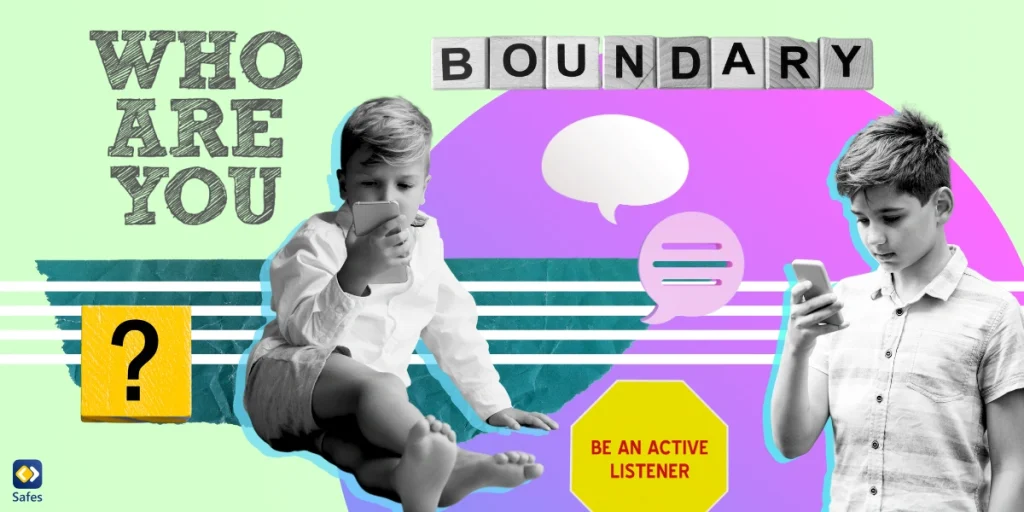The online disinhibition effect (ODE) has emerged as a noteworthy psychological phenomenon that significantly impacts the way people interact and communicate on the internet. This effect, characterized by a relaxation of social norms and inhibitions in online environments, can lead to both positive and negative consequences. In this blog, we delve into the concept of ODE, emphasizing the importance of parents understanding its implications. The primary goal of this blog is to educate parents about ODE and provide them with effective prevention strategies.
Download and Start Your Free Trial of the Safes Parental Control App
What is the Online Disinhibition Effect?
The online disinhibition effect (ODE) is a psychological phenomenon that relates to the way people behave and communicate differently in online environments compared to face-to-face interactions. At its core, ODE involves a relaxation of inhibitions and a deviation from conventional social norms when individuals engage with others through digital means. This can manifest in several ways, including increased self-disclosure, a tendency to be more candid or blunt, and a willingness to express emotions or opinions more freely.
To grasp the concept better, we’ve showcased the following examples:
- In online forums, individuals may share deeply personal stories or emotions they might hesitate to discuss in person.
- On social media platforms, users may engage in debates or make controversial comments, often adopting a more aggressive tone than they would in face-to-face conversations.
- In online gaming communities, players may frequently encounter instances of trash-talking or aggressive behavior that can escalate quickly, driven by the relative anonymity of the digital space.
These examples highlight how the online disinhibition effect can lead to both positive and negative online interactions, making it crucial for parents to understand its nuances in today’s digital age.
The Psychological Ground of ODE
The elements of ODE are multifaceted and can be attributed to several key factors. For starters, anonymity is important because it allows people to hide their genuine identities behind online aliases or pseudonyms. This anonymity allows people to feel detached from the repercussions of their actions, allowing them to express themselves more frankly or indulge in behaviors they might shun in face-to-face conversations. Second, the concept of invisibility in online contacts encourages a sense of distance because individuals do not see the immediate reactions or emotions of others with whom they engage. This absence of visual clues might lead to a decreased sense of empathy, making it easier to participate in potentially harmful or unpleasant behaviors. Lastly, the internet’s relatively limited consequences for online actions contribute to ODE, as the repercussions for uncensored behavior are often less severe than in offline settings. These psychological factors collectively encourage individuals to take risks, share more personal information, and engage in communication styles that differ significantly from their real-world interactions, making it crucial for parents to recognize and address these influences in the digital realm.
The Risks of ODE
ODE poses a range of potential dangers, making it vital for parents to be aware of its risks in the digital age. Firstly, ODE can expose children to cyberbullying, where they may encounter hurtful comments, harassment, or even threats from peers or strangers online. Secondly, the relaxed inhibitions associated with ODE can lead to the inadvertent sharing of sensitive personal information, such as addresses, phone numbers, or financial details, placing children at risk of identity theft or online exploitation. Additionally, engaging in inappropriate conversations or sharing explicit content under the influence of ODE can have serious legal and social consequences, affecting a child’s future opportunities and reputation. Left unchecked, ODE can lead to long-term consequences, including damaged self-esteem, increased vulnerability to online threats, and a perpetuation of risky online behaviors that can persist into adulthood. Therefore, understanding these risks and taking proactive measures to mitigate them is crucial for parents aiming to protect their children in the digital realm.

Recognizing Signs of ODE in Your Child
Recognizing signs of ODE in your child is essential for parents seeking to safeguard their well-being in the digital age. Common behavioral changes in children experiencing ODE include a notable increase in screen time, a sudden withdrawal from offline social activities, and a tendency to become more secretive about their online interactions. Communication challenges can also arise, as children may exhibit a reluctance to discuss their online experiences or display mood swings and heightened sensitivity when confronted about their digital behavior. Recognizing such signs is important for parents in addressing potential issues and guiding their children toward safer and more responsible online behavior.
Strategies to Prevent ODE
Preventing ODE in your child requires a multifaceted approach that combines awareness and active involvement. First and foremost, open communication with your child is crucial. Fostering an environment where your child feels comfortable sharing their online experiences and concerns is crucial. Tips for fostering open dialogue include creating a non-judgmental space, asking open-ended questions, and refraining from immediate criticism or punishment when they do open up. Active listening plays a pivotal role here, as it shows your child that you genuinely value their perspective and emotions.
Setting boundaries and utilizing parental control apps are also effective strategies. Parental control apps, like Safes, can help you monitor and restrict your child’s online activities, ensuring they navigate the digital world safely. Parental controls can also be used as a response to the disinhibition effect. Establishing clear rules and guidelines regarding screen time, appropriate websites or apps, and privacy settings will provide your child with a structured online experience. Safes can be used on iOS and Android platforms. Explore how Safes can help you implement these rules effectively with a 14-day free trial. For more information on how to use parental controls on different platforms click on the related resource:
- Windows parental controls
- Macbook parental controls
- Parental controls on android
- iPhone parental controls
Teaching online etiquette and instilling responsible online behavior is another critical aspect of preventing ODE. Emphasize the impact of words and actions in the digital sphere, encouraging your child to treat others online as they would in person.
Balancing trust and supervision when monitoring your child’s online activity is essential. While it’s vital to respect their privacy, periodic checks and discussions about their online experiences will help ensure their safety and adherence to established guidelines. By implementing these strategies, parents can proactively address ODE and foster a healthier, more responsible digital presence for their children.

Conclusion
In conclusion, parents today face the critical task of navigating the digital landscape with their children. Understanding ODE is crucial to ensuring their children’s safety and well-being. Key takeaways for parents include the need to grasp the concept of ODE, recognize signs of its influence on their children’s online behavior, and implement prevention strategies to mitigate its risks. By understanding ODE’s psychological underpinnings and potential dangers, parents can equip themselves to protect their children effectively. To sum it up, it’s the combination of awareness, communication, and proactive measures that empower parents to guide their children safely through the complexities of the online world, ensuring a positive and responsible digital presence.
Your Child’s Online Safety Starts Here
Every parent today needs a solution to manage screen time and keep their child safe online.
Without the right tools, digital risks and excessive screen time can impact children's well-being. Safes helps parents set healthy boundaries, monitor activity, and protect kids from online dangers—all with an easy-to-use app.
Take control of your child’s digital world. Learn more about Safes or download the app to start your free trial today!




